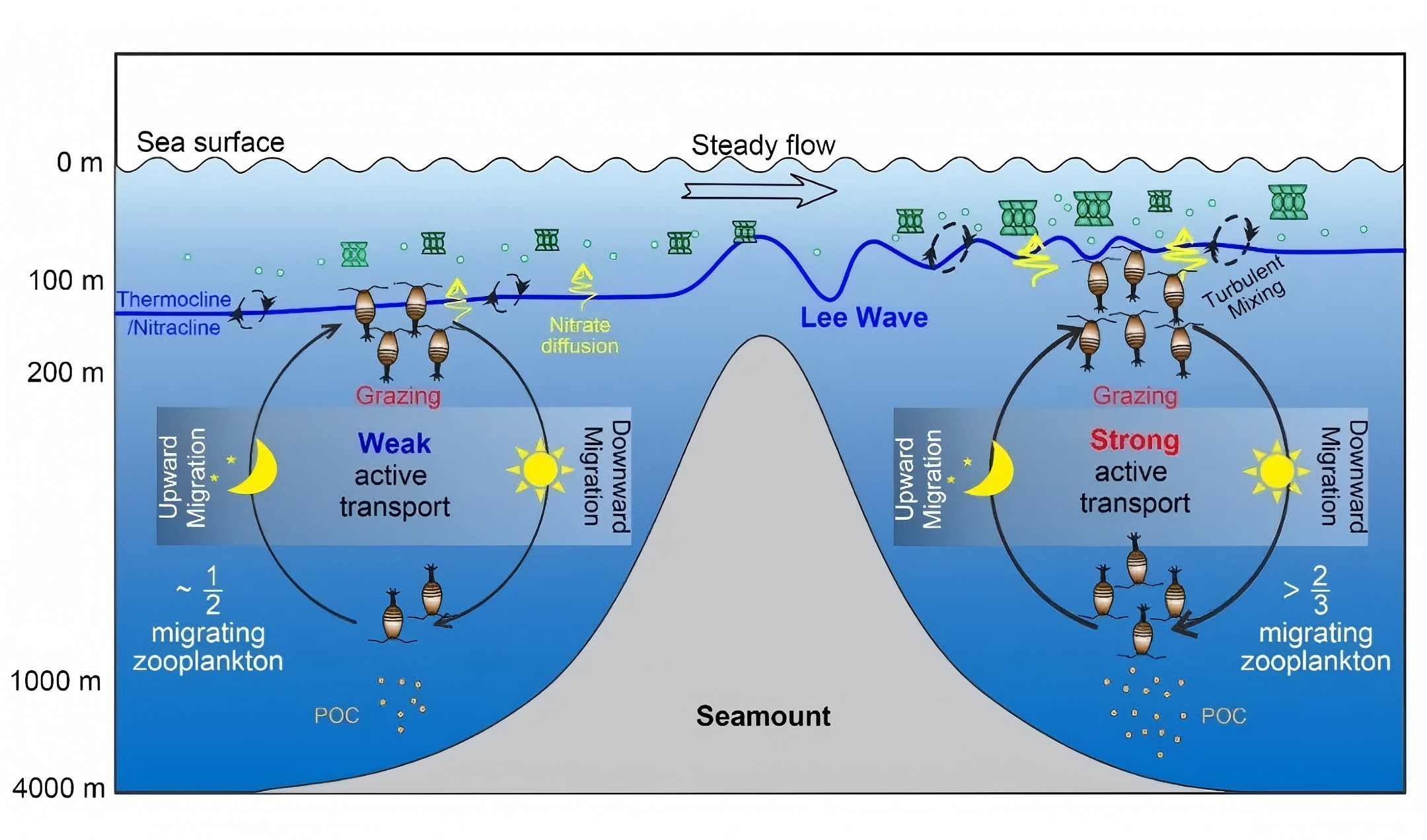我所在Science子刊发文揭示寡营养区海山生态绿洲的形成机制
Title: New Study in Science Advances by Our Institute Reveals Formation Mechanism of Ecological Oasis in Oligotrophic Seamount Regions
Researchers from the Marine Ecosystem Dynamics Laboratory and Marine Biogeochemistry Research Team at our institute have made significant progress in studying the formation mechanism of seamount ecosystems. Their findings, titled "Seamounts Generate Efficient Active Transport Loops to Nourish the Twilight Ecosystem," have been published in Science Advances.
Using multidisciplinary field observation data integrating physics, chemistry, and biology, this study first reveals the process by which ocean currents, when flowing over seamount topographies in oligotrophic seas, drive the formation of high biomass in the euphotic zone and high-intensity diel vertical migration (DVM) of zooplankton, which in turn facilitates efficient organic matter export. This study provides new insights into the formation mechanism of seamount ecosystems, highlighting that, unlike short-term, sporadic, and mobile production enhancements caused by mesoscale eddies, seamounts standing at fixed locations can continuously promote phytoplankton blooms and efficient organic matter export, nourishing the mesopelagic and benthic ecosystems of seamounts, and forming a three-dimensional ecological oasis linking the euphotic zone with the deep sea.
The first author of the paper is Wang Xinyang, a jointly trained PhD student from our institute and Shanghai Jiao Tong University. The co-corresponding authors are Researcher Chen Jianfang and Researcher Li Hongliang from our institute. Collaborators include Associate Researcher Zhang Jingjing, Researcher Zhang Dongsheng, Researcher Xie Xiaohui from our institute, Professors Xie Wei and Yin Kedong from Sun Yat-sen University, Professor Diana Ruiz-Pino from Sorbonne University, and Professor Gao Shuji from Hainan University.
Nearly half of the world's seamounts are located in oligotrophic "marine deserts," yet they nurture abundant fishery resources and benthic organisms, providing habitats for numerous species and serving as "ecological oases" in the ocean. Traditional theories on seamount productivity enhancement suggest that the complex hydrodynamic processes in seamount areas promote nutrient supply and primary production response in the euphotic zone, known as the "seamount effect." However, it remains unclear whether the organic matter produced during this process can be transferred to higher trophic levels along the food chain and whether it provides energy and material sources for deep-sea ecosystems. To address this issue, this study focuses on the main line of current-topography-upper primary production and organic matter export, conducting multidisciplinary comprehensive surveys and research on biogeochemical processes in the upper layer of seamounts.
The research team used self-integrated multi-parameter biochemical profilers, including Conductivity-Temperature-Depth (CTD) sensors, in-situ Ultraviolet Absorption Spectrophotometric Nitrate Analyzer (Deep SUNA), fluorescence sensors, and Underwater Video Profilers (UVP), to obtain the spatiotemporal variation characteristics of hydrodynamic environmental parameters, nutrient content and diffusion flux, phytoplankton biomass, copepod zooplankton biomass, and particulate organic carbon (POC) export flux in the Xizhi North Seamount in the South China Sea. The results show that the coupling of seamount downstream current fields, topography, and ecology creates an efficient pathway for organic matter from production to export, namely the "active export loop" mediated by diel vertical migration and feeding of zooplankton. This continuous and rapid export of organic matter may serve as a fresh food source for deep-sea ecosystems (Figure 1).
Figure 1: Conceptual diagram of the "active export loop" of particulate organic carbon driven by zooplankton under the influence of seamounts and current fields.
The study extended these findings to the North Pacific Subtropical Gyre (NPSG) to estimate the contribution of seamounts to organic carbon export. The results show that although shallow seamounts (<208 meters) account for only 0.74% of the NPSG sea area, they contribute 2.1 to 3.8% of the organic matter export flux in this region. This further emphasizes the higher biological pump output efficiency of seamounts in oligotrophic seas and their irreplaceable role in marine biological connectivity and fishery resources.














Please first Loginlater ~